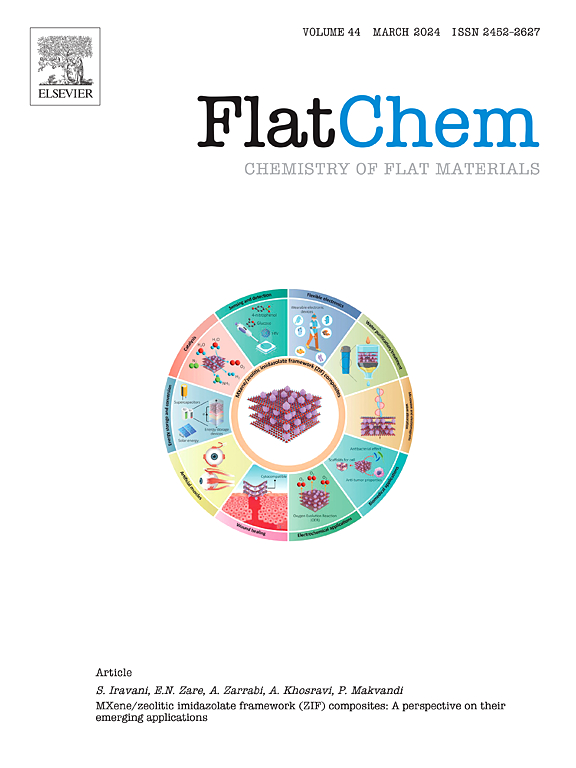0.937(Bi0.5Na0.5) TiO3-0.063BaTiO3光催化降解二元染料的极化效应
IF 6.2
3区 材料科学
Q2 CHEMISTRY, PHYSICAL
引用次数: 0
摘要
以太阳光和可见光活性0.937((Bi0.5Na0.5)TiO3) -0.063 (BaTiO3) (BNT-BT)为实验材料,考察极化光催化对染料降解效果的影响。为了验证样品的相位、振动模式、形貌、化学成分和带隙,分别利用x射线衍射(XRD)、拉曼光谱(Raman)和场发射扫描电镜(FE-SEM)、x射线光电子能谱(XPS)和漫反射光谱(DRS)进行了验证。在MB(亚甲基蓝)、RhB(罗丹明B)和二元染料溶液(MB + RhB; 50:50体积)(10 mg/L)中进行光催化实验。与未极化样品(48%)相比,极化样品对MB染料的降解率显著提高至72%。RhB染料降解率从极化样品的11%提高到42%。经极化后的BNT-BT样品在二元染料溶液中染料降解增强。极化样本分别降解了73%的MB和62%的RhB,而未极化样本分别降解了59%的MB和23%的RhB。在太阳光下,极化样品在90分钟内有效地降解了二元染料(分别为76% MB和78% RhB)。接下来,极化样品在初始二元染料浓度为10、15和20 mg/L时进行测试。最大速率常数为10mg /L (MB: 0.016, RhB: 0.0094 min - 1),最小速率常数为20mg /L (MB: 0.006, RhB: 0.0016 min - 1)。本文章由计算机程序翻译,如有差异,请以英文原文为准。

Effect of poling in solar/visible light photocatalysis for binary dye degradation using 0.937(Bi0.5Na0.5)TiO3–0.063BaTiO3
Solar light and visible light active 0.937((Bi0.5Na0.5)TiO3)–0.063(BaTiO3) (BNT-BT) was examined to investigate the effect of poling in photocatalysis for dye degradation efficacy. To verify the phase, vibrational modes, morphology, chemical composition and band gap of sample, X-ray diffraction (XRD), Raman spectroscopy and field emission scanning electron microscopy (FE-SEM), X-ray photoelectron spectroscopy (XPS) and DRS (diffuse reflectance spectroscopy) were utilized, respectively. In MB (Methylene Blue), RhB (Rhodamine B) and binary dye solution (MB + RhB; 50:50 volume) (10 mg/L) photocatalysis experiments were performed. Using poled sample, the degradation of MB dye was increased significantly to 72 % compared to unpoled sample (48 %). RhB dye degradation increased to 42 %, from 11 % in the poled sample. The poled BNT-BT sample showed enhanced dye degradation in the binary dye solution. The poled sample degraded 73 % MB and 62 % RhB individually, compared to 59 % MB, 23 % RhB in the unpoled sample. Under solar light, poled samples degraded binary dye efficiently (76 % MB, 78 % RhB individually) in 90 min. Next, poled samples were tested at initial binary dye concentrations of 10, 15, and 20 mg/L. Maximum rate constants observed at 10 mg/L (MB: 0.016, RhB: 0.0094 min−1) and minimum at 20 mg/L (MB: 0.006, RhB: 0.0016 min−1).
求助全文
通过发布文献求助,成功后即可免费获取论文全文。
去求助
来源期刊

FlatChem
Multiple-
CiteScore
8.40
自引率
6.50%
发文量
104
审稿时长
26 days
期刊介绍:
FlatChem - Chemistry of Flat Materials, a new voice in the community, publishes original and significant, cutting-edge research related to the chemistry of graphene and related 2D & layered materials. The overall aim of the journal is to combine the chemistry and applications of these materials, where the submission of communications, full papers, and concepts should contain chemistry in a materials context, which can be both experimental and/or theoretical. In addition to original research articles, FlatChem also offers reviews, minireviews, highlights and perspectives on the future of this research area with the scientific leaders in fields related to Flat Materials. Topics of interest include, but are not limited to, the following: -Design, synthesis, applications and investigation of graphene, graphene related materials and other 2D & layered materials (for example Silicene, Germanene, Phosphorene, MXenes, Boron nitride, Transition metal dichalcogenides) -Characterization of these materials using all forms of spectroscopy and microscopy techniques -Chemical modification or functionalization and dispersion of these materials, as well as interactions with other materials -Exploring the surface chemistry of these materials for applications in: Sensors or detectors in electrochemical/Lab on a Chip devices, Composite materials, Membranes, Environment technology, Catalysis for energy storage and conversion (for example fuel cells, supercapacitors, batteries, hydrogen storage), Biomedical technology (drug delivery, biosensing, bioimaging)
 求助内容:
求助内容: 应助结果提醒方式:
应助结果提醒方式:


